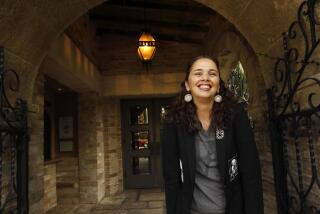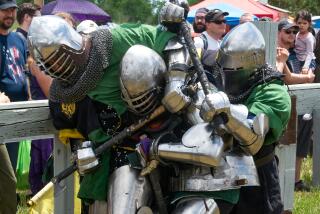FRINGE FESTIVAL : SWORDPLAY’S THE THING IN FRINGE’S ‘THE RING OF STEEL’
Because it is so distant from the realm of the machine, so pure in its condensation of the elements of primal conflict and romantic in its view of honor as an end in itself, swordplay still holds a special place in the culture. It is powerfully connected with the history of theater--think of “Cyrano de Bergerac” or any of innumerable Shakespearean battles--but always at the service of the play. What about an entire show of swordplay?
Theodore Katzoff and Phyllis Elliott thought it was a good idea, brought together a few fight choreographers they knew, those choreographers invited their friends, and out of months of preparation has come “The Ring of Steel,” performing Monday at the Mark Taper Forum.
“We won’t have a chance to be on the actual stage until the day of the performance,” said director Katzoff about having to function within the limits of the Taper’s “Babbitt” set. “We’ll do tech in the morning, dress rehearsal in the afternoon and perform at night.
“But it’s worth it. Getting it together for the Fringe (Festival) incentive to do something that’s been on my mind for 15 years. But the only way to do a show that displays a history of swordplay, and does it dramatically ,” said Katzoff, “was to get the best possible choreographers together, and use their ideas as well as the fights I conceived.”
Fights and choreography, though, often seem incompatible opposites. Elliott, the production coordinator, said, “Part of the trap is the word choreography . We don’t mean it as dance. In swordplay, each stroke is set and determined, placed and memorized. Yet it can’t be stagey.”
“Above all,” Katzoff added, “it’s acted. The acting is done with the body and the facial reactions. The sword action is done at the hilt, with the wrists.”
In a program that spans a vast literary landscape, from Homer’s “Iliad” to Bizet’s “Carmen” and also looks in on Tennyson’s “Idylls of the King,” the Japanese mystery “Rashomon,” Arthur Conan Doyle’s, “The White Company” and Rostand’s “Cyrano,” Katzoff and Elliott emphasize performance, and theater’s historical ties with the clash of steel, over mere exhibition fencing.
“We rehearse here,” said Katzoff, pointing around at the spacious, many-gabled Westside Fencing Center, which Katzoff runs with Elliott.
As brothers Stuart and Bob Chapin were clanging massive broadswords in their version of “Idylls” on the fencing mat under Katzoff’s watchful eye, choreographer Tony De Longis and crew were refining “Rashomon” just outside the Center’s entrance.
De Longis had to stand in for the absent Miguel Marcott, but his duel of katanas (medium-length samurai swords) with Wayne Sitz was a lightly funny jab at the fatuousness of so-called manliness.
Asked if he was poking fun at the macho code on display in “Ring,” choreographer Tony De Longis said, “Underneath this is a reminder that you’d better be sure what you’re fighting for before you commit yourself.”
Added Katzoff: “The idea is that you do great things without the expectation of being rewarded. That is true honor. It’s the concept that underlies all good swordplay, and the kind of thing you’d like to instill in people.”
More to Read
The biggest entertainment stories
Get our big stories about Hollywood, film, television, music, arts, culture and more right in your inbox as soon as they publish.
You may occasionally receive promotional content from the Los Angeles Times.










